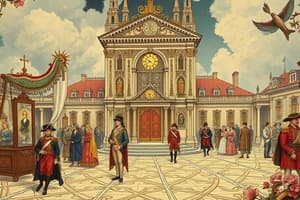Podcast
Questions and Answers
What was the result of the transfer of sovereignty from the monarchy to a body of French citizens in 1789?
What was the result of the transfer of sovereignty from the monarchy to a body of French citizens in 1789?
- The monarchy gained more power
- The French Revolution emerged and nationalism spread (correct)
- The king was abolished
- The citizens lost their rights
The Napoleonic Code established the right to property and lifted guild restrictions.
The Napoleonic Code established the right to property and lifted guild restrictions.
True (A)
What was the main feature of the Middle Class that emerged during the Industrialization period?
What was the main feature of the Middle Class that emerged during the Industrialization period?
The Middle Class included artisans, industrialists, businessmen, and others.
The tricolour was chosen as the new French ______________________.
The tricolour was chosen as the new French ______________________.
What was the main demand of the liberal middle class in 1848?
What was the main demand of the liberal middle class in 1848?
Napoleon took away the freedom of people by forcing them to join the French army.
Napoleon took away the freedom of people by forcing them to join the French army.
Match the following classes with their descriptions:
Match the following classes with their descriptions:
Where was the Frankfurt parliament convened on 18th May 1848?
Where was the Frankfurt parliament convened on 18th May 1848?
What was the outcome of the 1848 revolution in terms of women's suffrage rights?
What was the outcome of the 1848 revolution in terms of women's suffrage rights?
The Bourbon dynasty was overthrown in 1815.
The Bourbon dynasty was overthrown in 1815.
What was the main goal of the revolutionaries in European states in 1815?
What was the main goal of the revolutionaries in European states in 1815?
The Crown was offered to _______________________, King of Prussia, but he rejected it.
The Crown was offered to _______________________, King of Prussia, but he rejected it.
What was one of the major issues taken up by the liberal nationalists?
What was one of the major issues taken up by the liberal nationalists?
Match the following individuals with their corresponding actions:
Match the following individuals with their corresponding actions:
Conservatives in 1815 believed that a modern army and efficient bureaucracy could weaken autocratic monarchies.
Conservatives in 1815 believed that a modern army and efficient bureaucracy could weaken autocratic monarchies.
What was the outcome of the meeting of European powers in Vienna in 1815?
What was the outcome of the meeting of European powers in Vienna in 1815?
Flashcards are hidden until you start studying
Study Notes
French Revolution and Nationalism
- Nationalism emerged during the French Revolution in 1789, transferring sovereignty from the monarchy to French citizens.
- Key concepts introduced included la patrie (the fatherland) and le citoyen (the citizen).
- The tricolour was adopted as the new national flag.
Napoleonic Code
- Napoleon ruled France from 1799 to 1815, seizing power as First Consul in 1799.
- The Napoleonic Code established equality before the law and secured the right to property.
- Abolished birthrights and privileges, lifted guild restrictions, and imposed military conscription.
- Introduced censorship and increased taxes while diminishing political freedom.
New Middle Class Structure
- Society was restructured into three main classes based on work and culture:
- Aristocracy: Landowners connected by marriage, but a small population.
- Peasantry: The majority class, comprising most of the population.
- Middle Class: Emerged due to industrialization, including artisans and businessmen.
Liberalism and the 1848 Revolution
- A liberal revolution in 1848 was led by the educated middle class, advocating for parliamentary democracy and constitutional rights.
- Political associations formed to vote for an all-German National Assembly, meeting in Frankfurt.
- On May 18, 1848, 831 representatives gathered and drafted a constitution for a parliamentary monarchy.
- Crown offered to Frederick William IV, King of Prussia, who declined, uniting with monarchs against the assembly.
- The middle class dominated the parliament, and women participated actively, forming political associations and newspapers.
- Despite their involvement, women were denied voting rights.
Aftermath of the 1848 Revolution
- Post-1848, conservative monarchs in Central and Eastern Europe began implementing reforms from Western Europe prior to 1815.
- Reforms included the abolition of serfdom and bonded labor in Russia and Habsburg dominions.
New Conservatism Post-1815
- Conservatism became the dominant political force in Europe after 1815, supporting monarchy, the Church, and social hierarchies.
- Aimed to strengthen autocratic rule through modern armies and efficient bureaucracies, while eliminating feudalism.
- The Vienna Congress in 1815 reinstated the Bourbon dynasty and redrew Europe’s borders post-Napoleon.
The Role of Revolutionaries
- Secret societies emerged to educate and promote revolutionary ideologies against monarchical structures.
- Giuseppe Mazzini, an Italian revolutionary, played a significant role in advocating for democratic reforms and liberty throughout Europe.
Studying That Suits You
Use AI to generate personalized quizzes and flashcards to suit your learning preferences.




